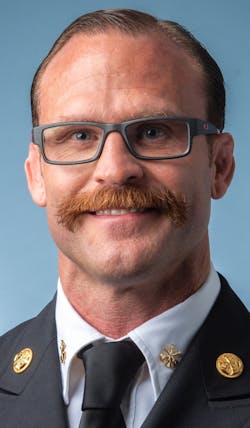As I continue to make my transition from captain to battalion chief, I’ve learned some valuable lessons that will assist in my growth as a leader.
The first few months were a difficult transition, but now I’m feeling the groove. The understanding of my responsibilities is much more obvious, and our team is growing together. It’s important to remember that when a new leader comes into a new position, there’s always a transition period, not just for the leader, but for the employees trying to adjust to the new leader as well.
For me, I try to utilize a few different steps to learn my place on the team but also to give the team confidence in their position. I used these steps when I made captain, and now I’m using them in my evolution as a battalion chief. I’m hopeful that they will work for you as well.
Read the room
First, I’m a student of the atmosphere. I think this is the most essential step because no one wants a new leader coming into a position and laying down the law with a power trip the first day. This is the quickest way to build resistance, so please, don’t do that.
The leader must learn the employees and what makes them tick. The leader must also learn the work culture of the group that they are now leading. This can be different based on the division (i.e., operations, training, administration, fire marshal). It’s not a one-size-fits-all situation. Different cultures require different techniques related to leadership. For me, I focus on the concept of servant leadership because I’ve seen it work with some incredible leaders in my department and other organizations nationwide.
Robert Greenleaf, credited with coining the term servant leadership, explains it as follows: “The servant-leader is servant first. It begins with the natural feeling that one wants to serve first. Then conscious choice brings one to aspire to lead. That person is sharply different from one who is leader first, perhaps because of the need to assuage an unusual power drive or to acquire material possessions.” This is quite different than the autocratic leadership style that dominated the fire service in the previous decades.
Learn from the people
Next, I watch, listen to and learn from the people. You may think this is the same as being a student of the atmosphere, but it’s not. This is when the leader must learn the habits of the personnel, both good and bad. There may be some items that are seen right off the bat that need to be addressed, but I always recommend letting the employees be themselves so you can get a true read on their work ethic, attitude and professionalism. Many of these factors will not be presented the first few days or weeks that a leader is in a new position. The newness of a leader will make people act different at first, but trust me, eventually, their true colors will be in the forefront.
During both of the aforementioned steps, I utilize Socratic questioning to allow the employees to be critical thinkers. Many times, people can solve their own issues and start the improvement process just by being stimulated with questions. For those who are unfamiliar with this method, Socratic questioning is the art of systematically asking questions to create a disciplined dialogue that requires thought to go in many different directions. With this type of questioning, a leader can evaluate complexities, find truth, explore what is known and what is not known, highlight problems, and distinguish what assumptions have been created in the culture of the group. Now, this technique is an educators’ technique specifically; however, when you’re leading, you’re educating. They go hand in hand.
Make improvements
Once I’ve done this for a good 3–6 months, I now have the information on how we can improve as a team. As in anything we do, research and reconnaissance are important because without good information, it will be difficult to make significant improvements. These improvements don’t have to be mind-blowing. Don’t find items to change just so you can say you did something. Find the items that need improvement so the team feels the changes were needed. This isn’t always popular because some changes you make as a new leader will rub your employees the wrong way, but remember, you were put into the position to make things better. This is a slippery slope so pay close attention to body language and attitude. This will be an obvious sign if the improvements are accepted or are being resisted. If the improvements are not being accepted at first, then you must do the job you are being paid to do—that’s be the leader and explain why you’re doing what you’re doing, which should have been done throughout the process. This goes a long way with the team.
Once all the research is complete, it’s time to take action. Start slow with these improvements. If you try to change an entire division or department in one day, it’s going to create resistance at an alarming rate that may not be able to be controlled. From experience, resistance is going to present itself when the rate of change is too much for people to keep up with. Again, don’t just make changes for the sake of making changes; do them to help the employees perform their jobs more effectively, efficiently and with higher morale. This isn’t an easy task, but I’ve seen it done and, unfortunately, been a part of the resistance, and now I’m leading for improvements to reduce resistance. It all comes full circle if you evolve.
Review the results
The final step is to review your results and be willing to adapt to other ways to be more effective. This may mean you have to circle back on changes you made that aren’t working. That’s OK. Don’t be afraid to look at your team and tell them that something you changed isn’t satisfactory. You must show humility and a willingness to listen to the team members. If you show that you don’t listen to them, why do you think they would listen to you? It’s reciprocal.
Be a team player
Throughout this process, you must remember that you’re not always right just because you have a gold badge and some bugles. The improvements made have very little to do with that; they have to do with building a stronger team. It’s not about you, it’s about the team. Without the team, the leader is nothing. Remember, leading is a team sport, so please, be a team player.

Dr. David Griffin
Dr. David Griffin is the assistant chief of administration in Charleston, SC. He was the operator of the first-due engine on June 18, 2007, when nine of his fellow firefighters perished. Griffin has come through the ranks in operations in every uniformed position, from firefighter to battalion chief and shift commander to his current position, during his 19-year career in Charleston. He has a bachelor's degree in education from The Citadel, a master's degree in executive fire service leadership, and a doctorate of education in organizational leadership and development. Griffin is the author of "In Honor of The Charleston 9: A Study of Change Following Tragedy," among three other books. He is an international speaker and instructor, a certified Chief Fire Officer and Chief Training Officer with The Center for Public Safety Excellence, an IFSAC/Pro Board-certified Fire Officer IV and a graduate of the Executive Fire Officer Program from the National Fire Academy. He is a graduate of Harvard University's Kennedy School of Executive Education program: Senior Executives in State and Local Government and of the Psychology of Leadership program at Cornell University's SC Johnson College of Business. Griffin is the owner of On A Mission, LLC, at drdavidgriffin.com.






